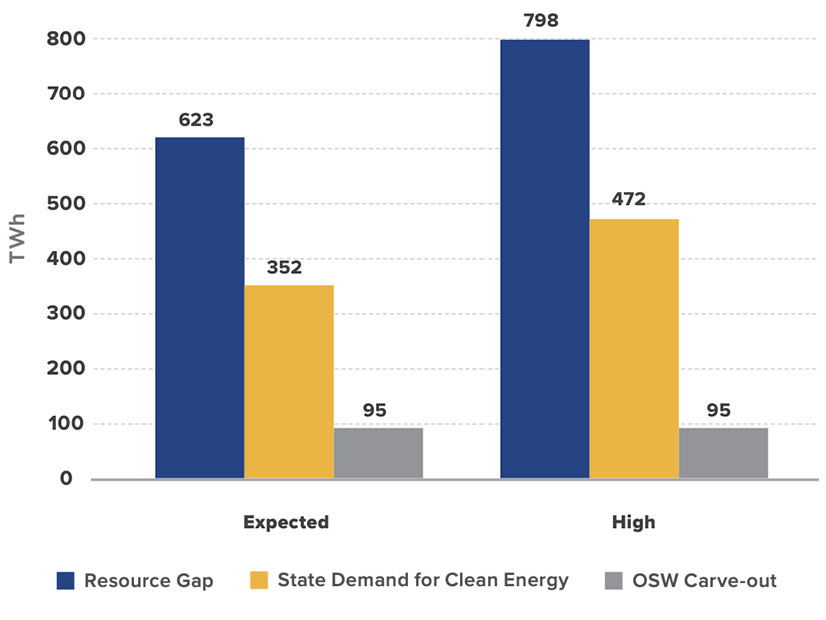PJM should adopt a more proactive transmission planning process to deal with the changing resource mix and growing demand on its system in the coming 15 years, according to a report released June 4 by Americans for a Clean Energy Grid (ACEG).
“Transmission Planning for PJM’s Future Load and Generation” was written by Grid Strategies and David Gardiner and Associates.
“This report takes a deep dive into some of the inputs that PJM needs to take a closer look at in conducting more holistic scenario planning,” ACEG Executive Director Christina Hayes said in an interview June 3. “PJM has been making progress in evolving its transmission planning in recent months, and we’re excited about those efforts. We know that more will be required in implementing Order No. 1920, and we believe this report provides a road map to doing so.”
Skeptics of proactive planning argue that transmission plans are full of uncertainty and speculation, but ignoring the massive changes impacting the energy industry and continuing to plan reactively will not address those concerns, the report says. Uncertainty is best addressed by incorporating the best data on the future resource mix and running different scenarios to determine the optimum set of solutions, as Order 1920 requires.
The report forecasts demand will be higher than the forecast PJM released early this year by about 8% in its “Expected” scenario and 18% for a high-growth scenario. Even those scenarios might be conservative given the continual announcements of new manufacturing facilities and data centers.
“We find PJM will need an additional 623 TWh of annual energy generation by 2040 to meet this resource gap under our Expected scenario — equivalent to 76% of PJM’s 2023 generation,” the report says. “Under the High scenario, PJM faces a larger resource gap in 2040 and will need to nearly double current energy generation by adding 798 TWh. The increase is driven by higher electrification estimates leading to larger load growth and higher amounts of generation retirements due to shorter plant lifespan assumptions.”
The biggest difference between PJM’s load forecast and the two scenarios in the report is the latter assume higher demand from electrification and higher generation retirements. The electrification estimates in the report are based on projections from the National Renewable Energy Laboratory, while the report says PJM’s Independent Market Monitor has estimated higher retirements than the RTO itself.
“I think the one thing we can be certain of with every single demand forecast we have seen recently is that they will all be wrong. Right?” Hayes said. “Nobody is going to forecast the future with 100% certainty.”
But one thing that is certain is that several factors are leading to higher demand, and it makes sense to ensure transmission is ready to meet that on time, she added.
“We do need to be thoughtful and measured in how we plan for it,” Hayes said. “But in doing so, we need to take the long view because if we wait until it’s upon us, we’re either going to have outages, or resources that we want to keep in the United States are going to end up being located outside the United States, which is a national security problem. Or we’re going to develop the grid in a more expensive way.”
The Regional Transmission Expansion Process in place now includes a short-term reliability process looking out five years and another reliability planning process that looks out 15 years, both using base cases based on power flow models that includes capacity cleared in the market and only announced retirements. Retirements require only 90 days’ advance notice.
Better anticipating retirements can help significantly, as seen recently with the Brandon Shores coal plant in Baltimore. PJM found the grid would need $785 million in transmission upgrades for it to retire reliably; those will take until 2028 to complete, 3.5 years from the plant’s desired retirement, the report says. A reliability-must-run deal for the plant might cost consumers an additional $250 million a year, which could have been avoided or lowered with proactive planning.
“In Order 1920, FERC did a good job of identifying the various factors, looking at fuel costs and market impacts and likely resource retirements, and doing a deep dive on what the generation resource mix is likely to be in five to 10 to 20 years, and rolling those factors into multivalue, holistic planning,” Hayes said.
Another issue in PJM is a growing share of renewables as state and federal policies, lower costs and consumer demand push more and more onto the grid. While some states have policies driving that transition, others are not interested in it at all. Hayes argued that holistically planning the entire grid would even benefit the latter.
“There’s a lot of flexibility in FERC’s rule to allow states with additional goals to assume part of the costs and ensure that states that also partake in the economic/reliability benefits contribute as well,” Hayes said. “It’s the idea of a region being seen as a region rather than a loose collection of states; it is just more cost effective for the region to plan transmission together and then allocate the costs.”



